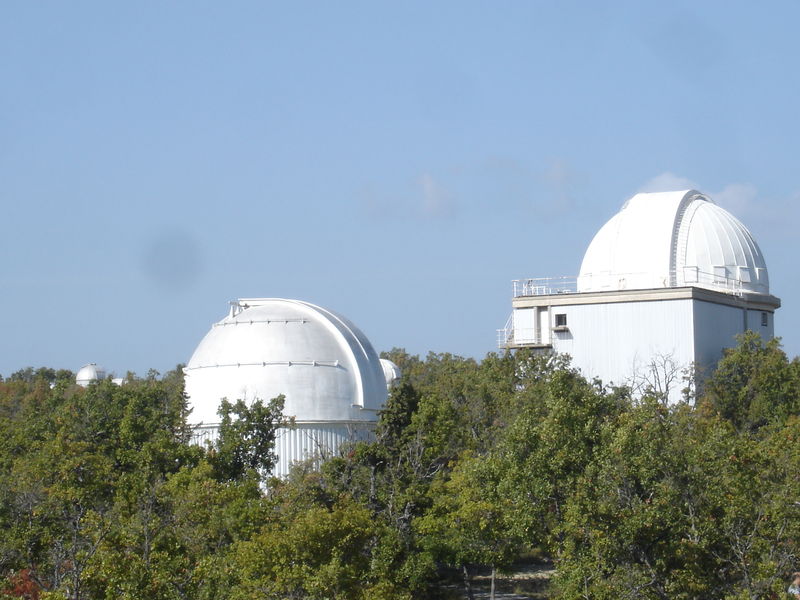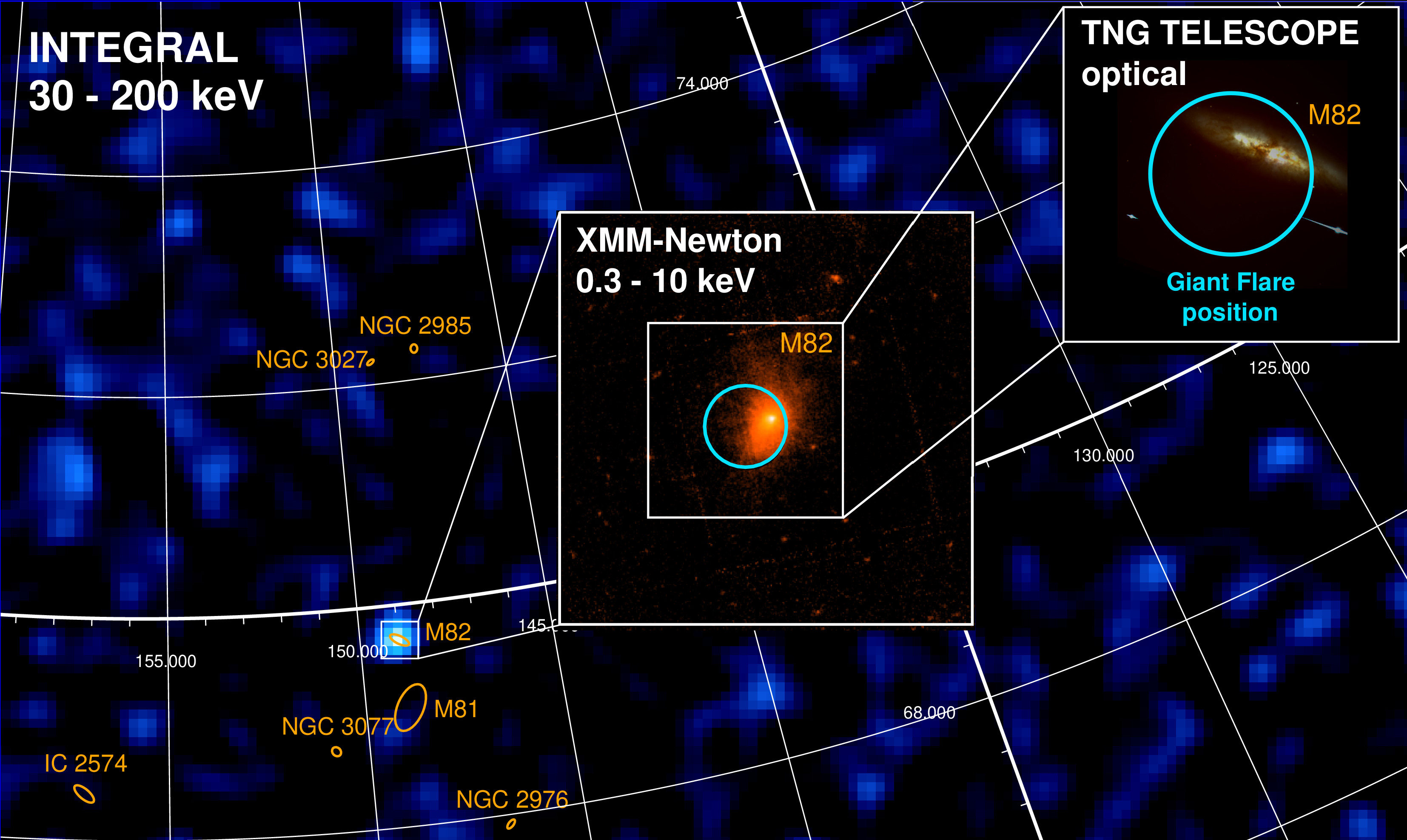From The University of Geneva [Université de Genève] (CH)
4.24.24
Carlo Ferrigno
Senior research associate
Astronomy Department
Faculty of Science
UNIGE
+41 22 379 21 78
Carlo.Ferrigno@unige.ch
Volodymyr Savchenko
Senior research associate
Astronomy Department
Faculty of Science
UNIGE
LASTRO (EPFL)
Volodymyr.Savchenko@unige.ch
Thanks to ESA satellites, an international team including UNIGE researchers has detected a giant eruption coming from a magnetar, an extremely magnetic neutron star.

While ESA’s satellite INTEGRAL was observing the sky, it spotted a burst of gamma-rays – high-energy photons – coming from the nearby galaxy Messier 82.

Only a few hours later, ESA’s XMM-Newton X-ray space telescope searched for an afterglow from the explosion but found none.

An international team, including researchers from the University of Geneva (UNIGE), realized that the burst must have been an extra-galactic flare from a magnetar, a young neutron star with an exceptionally strong magnetic field. The discovery is published in the journal Nature.
On 15 November 2023, ESA’s satellite INTEGRAL spotted a sudden explosion from a rare object. For only a tenth of a second, a short burst of energetic gamma-rays appeared in the sky. “The satellite data were received in the INTEGRAL Science Data Centre (ISDC), based on the Ecogia site of the UNIGE Astronomy Department, from where a gamma-ray burst alert was sent out to astronomers worldwide, only 13 seconds after its detection,” explains Carlo Ferrigno, senior research associate in the Astronomy Department at UNIGE Faculty of Science, PI of the ISDC and co-author of the publication.
The IBAS (Integral Burst Alert System) software gave an automatic localization coinciding with the galaxy M82, 12 million light-years away. This alert system was developed and is operated by scientists and engineers from the UNIGE in collaboration with international colleagues.
A curious signal from a nearby galaxy
“We immediately realized that this was a special alert. Gamma-ray bursts come from far-away and anywhere in the sky, but this burst came from a bright nearby galaxy,” explains Sandro Mereghetti of the National Institute for Astrophysics (INAF–IASF) in Milan, Italy, lead author of the publication and contributor of IBAS. The team immediately requested ESA’s XMM-Newton space telescope to perform a follow-up observation of the burst’s location as soon as possible. If this had been a short gamma-ray burst, caused by two colliding neutron stars, the collision would have created gravitational waves and have an afterglow in X-rays and visible light.
In the past 50 years, only three giant flares have been identified as coming from magnetars in our galaxy.
However, XMM-Newton’s observations only showed the hot gas and stars in the galaxy. Using ground-based optical telescopes, including the Italian Telescopio Nazionale Galileo and the French Observatoire de Haute-Provence, they also looked for a signal in visible light, starting only a few hours after the explosion, but again did not find anything.


Observatoire de Haute-Provence
With no signal in X-rays and visible light, and no gravitational waves measured by detectors on Earth (LIGO/VIRGO/KAGRA), the most certain explanation is that the signal came from a magnetar.
Magnetars: mega-magnetic stars, recently dead
“When stars more massive than eight times the Sun die, they explode in a supernova that leaves a black hole or neutron star behind.

Neutron stars are very compact stellar remnants with more than the mass of the Sun packed into a sphere with the size of the Canton of Geneva.

They rotate quickly and have strong magnetic fields.” explains Volodymyr Savchenko, senior research associate in the Astronomy Department at UNIGE Faculty of Science, and co-author of the publication. Some young neutron stars have extra strong magnetic fields, more than 10 000 times that of typical neutron stars. These are called magnetars. They emit energy away in flares, and occasionally these flares are gigantic.
However, in the past 50 years of gamma-ray observations, only three giant flares have been identified as coming from magnetars in our galaxy. These outbursts are very strong: one that was detected in December 2004, came from 30 000 light-years from us but was still powerful enough to affect the upper layers of Earth’s atmosphere, like the Solar flares, coming from much closer to us, do.

The detection was sent to the Integral science data centre in Geneva, where software determined it came from the nearby galaxy Messier 82. The small square on Integral’s map shows the location of the burst. The blue circle on the two cut-out images shows the corresponding location. © ESA/Integral, ESA/XMM-Newton, INAF/TNG, M. Rigoselli (INAF)
The flare detected by INTEGRAL is the first firm confirmation of a magnetar flare outside of the Milky Way. Messier 82 is a bright galaxy where star formation takes place. In these regions, massive stars are born, live short turbulent lives and leave behind a neutron star. “The discovery of a magnetar in this region confirms that magnetars are likely young neutron stars,” adds Volodymyr Savchenko. The search for more magnetars will continue in other extra-galactic star-forming regions, to understand these extraordinary astronomical objects. If astronomers can find many more, they can start to understand how often these flares happen and how neutron stars lose energy in the process.
INTEGRAL, a key instrument in a race against time
Outbursts of such short duration can only be captured serendipitously when an observatory is already pointing in the right direction. This makes INTEGRAL with its large field of view, more than 3000 times greater than the sky area covered by the Moon, so important for these detections.
Carlo Ferrigno explains: “Our automatic data processing system is highly reliable and enables us to alert the community immediately.” When unexpected observations like this are picked up, INTEGRAL and XMM-Newton can be flexible in their schedules, which is essential in time-crucial discoveries. In this case, had the observations been performed even just a day later, there would not have been such strong proof that this was indeed a magnetar and not a gamma-ray burst.
See the full article here.
Comments are invited and will be appreciated, especially if the reader finds any errors which I can correct.
five-ways-keep-your-child-safe-school-shootings
Please help promote STEM in your local schools.
The University of Geneva [Université de Genève] (CH) is a public research university located in Geneva, Switzerland.
It was founded in 1559 by John Calvin as a theological seminary and law school. It remained focused on theology until the 17th century, when it became a center for Enlightenment scholarship. In 1873, it dropped its religious affiliations and became officially secular. Today, the university is the third largest university in Switzerland by number of students. In 2009, the University of Geneva celebrated the 450th anniversary of its founding. Almost 40% of the students come from foreign countries.
The university has a diverse student body, with students from over 150 countries. It is also home to numerous research centers and institutes, including the Geneva Centre for Security Policy, the Global Studies Institute, and the Institute of Global Health.
The university holds and actively pursues teaching, research, and community service as its primary objectives. The university has been ranked very highly worldwide by the Shanghai Academic Ranking of World Universities, and by the QS World University Rankings, and the TIMES Higher Education World University Ranking.
During the French annexation of Geneva (1798–1813), the school was reorganized into a more universal format, with the introduction of degrees and its division in faculties. This process of modernization continued into the period of national Restoration.
UNIGE is a member of the League of European Research Universities (EU) (including academic institutions such as University of Amsterdam [Universiteit van Amsterdam] (NL), University of Cambridge (UK), Ruprecht Karl University of Heidelberg, [Ruprecht-Karls-Universität Heidelberg] (DE), University of Helsinki [ Helsingin yliopisto; Helsingfors universitet] (FI) and University of Milan [Università degli Studi di Milano Statale] (IT)). The university is a member of Coimbra Group (EU) and the European University Association (EU).
The University of Geneva is structured in various faculties and interfaculty centers which are representing teaching, research and service to society in the various disciplines.
Faculties
The university is composed of nine faculties:
Faculty of Sciences
Faculty of Medicine
Faculty of Humanities
Faculty Geneva School of Economics and Management (GSEM)
Faculty Geneva School of Social Sciences (G3S)
Faculty of Law (Geneva Law School)
Faculty of Theology
Faculty of Psychology and Education
Faculty of Translation and Interpreting
Interfaculty centers
The university is composed of fourteen interfaculty centers. Amongst others:
Institute for Reformation History (Reformation)
Interfaculty Center for Informatics (computer science)
Institute for Environmental Sciences (energy policy)
The Global Studies Institute
Interfaculty Center of Gerontology (gerontology)
Swiss Center for Affective Sciences (affective science)
Associated institutions
The university has also several partnerships with the nearby institutions, where students at the university may take courses.
Graduate Institute of International and Development Studies (IHEID)
Bossey Ecumenical Institute of the World Council of Churches
Wyss Center for Bio- and Neuro-engineering
Swiss National Supercomputing Centre
Art-Law Centre
Center for Biomedical Imaging (CIBM)
University Centre of Legal Medicine (CURML)
The Institute for Work and Health (IST)
The University of Geneva has had a budget of as much as 760 million. It mostly comes from the cantonal subventions, the other notable contributors being the federal state and the tuition fees.
International partnerships
Students at UNIGE have the possibility to study abroad for a semester or a year during their degree. Partner universities include Free University of Berlin, Harvard Law School, École Normale Supérieure, Trinity College Dublin, Erasmus University of Rotterdam, Université Libre de Bruxelles, King’s College London, McGill University, HEC Montreal, University of Ottawa, University of Oxford, Uppsala University, Johns Hopkins University, University of Michigan, UCLA, University of Southampton, University of Sydney, University of Tokyo.
The key sectors of research at the University of Geneva are sciences (molecular biology, bio-informatics, etc.), elementary physics, astrophysics, economics, social sciences, psychology, chemistry, biochemistry and biophysics.
UNIGE is home to six national research centers: in genetics (Frontiers in Genetics), in material sciences (MaNEP), in study of emotions (Affective Sciences), in chemical biology (with EPFL), in study of mental illness (Synaptic, with EPFL and Unil), in study of life path (with Unil). UNIGE also carries research in international studies since the creation in 2013 of the Global Studies Institute, in finance with the Geneva Finance Research Institute, and in environmental studies, with the creation in 2009 of the Institut des sciences de l’environnement.
Famous discoveries have been made by researcher working at UNIGE including the discoveries of extrasolar planets by Michel Mayor, and of quantum teleportation by Nicolas Gisin.
The university has hosted several Nobel laureates as students, researchers and/or professors. It has also hosted or graduated Fields Medal laureates.


